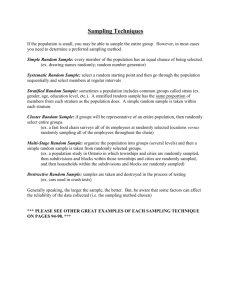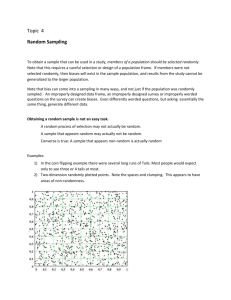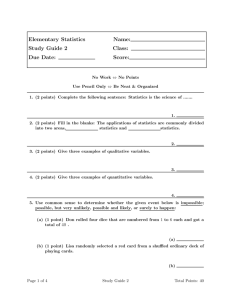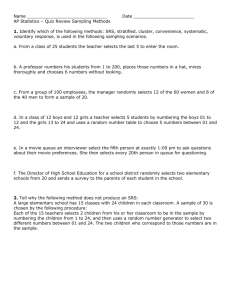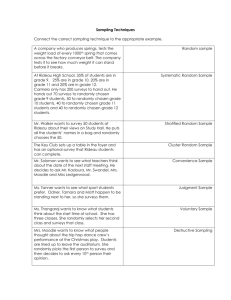Ch1 Handout
advertisement
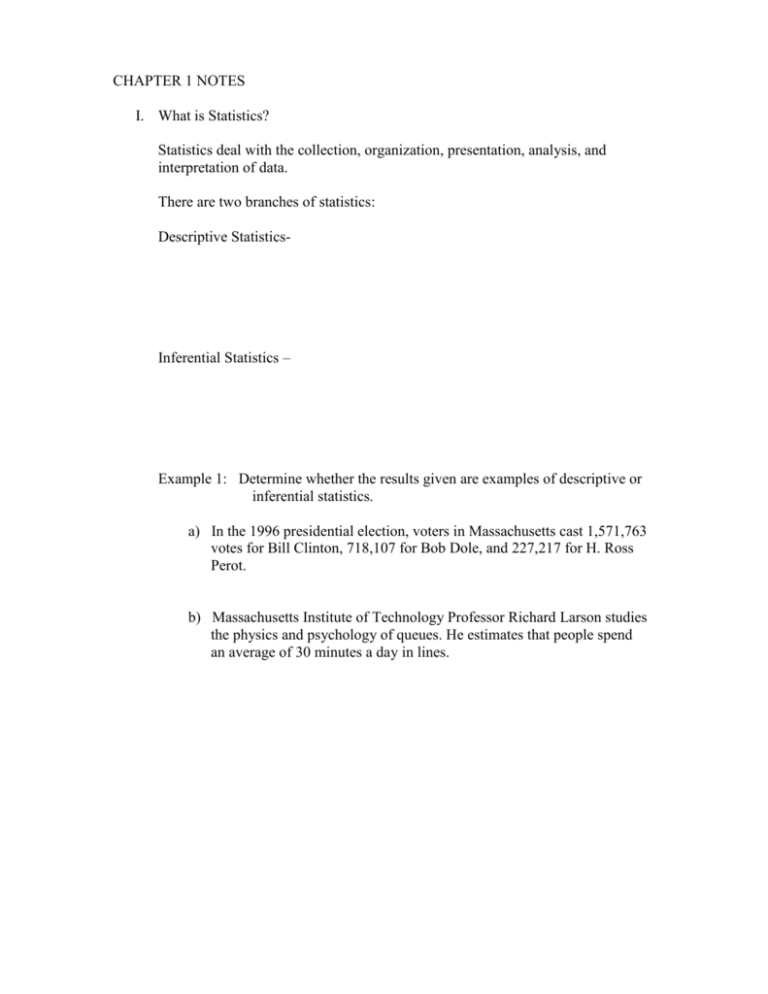
CHAPTER 1 NOTES I. What is Statistics? Statistics deal with the collection, organization, presentation, analysis, and interpretation of data. There are two branches of statistics: Descriptive Statistics- Inferential Statistics – Example 1: Determine whether the results given are examples of descriptive or inferential statistics. a) In the 1996 presidential election, voters in Massachusetts cast 1,571,763 votes for Bill Clinton, 718,107 for Bob Dole, and 227,217 for H. Ross Perot. b) Massachusetts Institute of Technology Professor Richard Larson studies the physics and psychology of queues. He estimates that people spend an average of 30 minutes a day in lines. II. Parameter and Statistic Population – Sample – Parameter – Statistic – Example 1: The actual average height of all adult human males in the US is 5’9.4”. Example 2: 60% of the households sampled from the US own more than one car. Example 3: A mall survey found 36% of women prefer lipstick to lip balm. Example 4: Currently there are 10,713 house units in Delano, CA Example 5: Consider the problem of estimating the average grade point average (GPA) of the 750 seniors at a college. a) What is the population? How many data values are in the population? b) What is the parameter of interest? c) Suppose that a sample of 10 seniors is selected, and their GPAs are 2.72, 2.81, 2.65, 2.69, 3.17, 2.74, 2.57, 2.17, 3.48, 3.10. Calculate a statistic that you would use to estimate the parameter. d) Suppose that another sample of 10 seniors was selected. Would it be likely that the value of the statistic is the same as in part (c)? Why or why not? Would the value of the parameter remain the same? III. Misuse of Statistics / Bias Misuse of Statistics: Types of Bias / Misuse IV. Types of Data A variable – a characteristic that changes for different individuals or objects under study. Variables can be classified as qualitative (categorical) or quantitative (numerical). Quantitative variables can be further classified into discrete or continuous data. Discrete variables assume values that can be counted. (e.g. # of books, # of desks) Continuous variables can assume all values between any two specific values. (e.g. length, time, etc.) Example 1: Classify each variable as qualitative or quantitative. If the variable is quantitative, further classify it as discrete or continuous. a) Number of people in a classroom b) Weights of new born babies in a hospital c) Eye colors of students in Math 22 V. Levels of Measurement Nominal level of measurement – Ordinal level of measurement – categorical data that can be ranked. (e.g. Rating scale- poor, good, excellent) Interval level of measurement – numerical data that can be ranked; the differences between units of measure do exist; however, there is no true zero. (e.g. sea level, temperature) Ratio level of measurement – numerical data that can be ranked; the differences and ratios between units of measure do exist, and there exists a true zero. EXAMPLE : Classify each as nominal, ordinal, interval, or ratio level data. a) Sizes of cars b) Nationality of each student c) IQ of each student d) Weights of new born babies VI. Data Collection Random Sampling – each member of the population has an equal chance of being selected. e.g. Lottery Simple Random Sampling - simple random sample of n subjects is selected in a way that every possible sample of the same size n has the same chance of being chosen. Systematic Sampling – an initial experimental unit is randomly selected, then every kth unit is being chosen for sampling e.g. A quality control engineer selects every 200th TV remote control from an assembly line and conducts a test of qualities. Convenience Sampling – e.g. An NBC television news reporter gets a reaction to a breaking story by polling people as they pass the front of his studio. Stratified Sampling – e.g. A General Motors researchers has partitioned all registered cars into categories of subcompact, compact, mid-size, and full-size. He is surveying 200 car owners from each category. Cluster Sampling – the population area is divided into sections (or clusters), then randomly select some of those clusters, and then choose a sample or all the members from those selected clusters. e.g. Two of the nine colleges in the L.A. district are randomly selected, then all faculty from the two selected college are interviewed. Example 1: Consider the following situations listed in a-d and identify which sampling method is being used. Then write the corresponding number in the blank. a) To estimate the proportion of Bakersfield College students who prefer hip-hop music to other forms of music, a researcher obtains a listing of all the students at Bakersfield and contacts every 20th student on the list. b) A statistics instructor teaching 300 students wants to determine if the class understands different sampling methods. She selects a sample of 10 students, all from the 1st row. c) To determine employee satisfaction, corporate management for Target divide all stores into 3 regions: West Coast, East Coast, and Midwest. Then 100 employees are randomly selected from each region to complete an employee survey. d) Sharp Healthcare wants to administer random drug tests in its hospitals. An outside research company randomly selects 4 hospitals and then drug tests every employee at those hospitals. Example 2: Identify which of these types of sampling is used: random, systematic, convenience, stratified, or cluster. __________ a) A marketing expert for MTV is planning a survey in which 500 people will be randomly selected from each age group of 10-19, 20-29, and so on. b) A news reporter stands on a street corner and obtains a sample of city residents by selecting five passing adults about their smoking habits. c) In a Gallup poll of 1059 adults, the interview subjects were selected by using a computer to randomly generate telephone numbers that were then called. d) At a police sobriety checkpoint at which every 10th driver was stopped and interviewed. e) A market researcher randomly selects 10 blocks in the Village of Newport, then asks all adult residents of the selected blocks whether they own a DVD player. f) General Foods plans to conduct a marketing survey of 100 men and 100 women in Orange County. g) CNN is planning an exit poll in which 100 polling stations will be randomly selected and all voters will be interviewed as they leave the premises. h) An executive mixes all the returned surveys in a bin, then obtains a sample group by pulling 50 of those surveys. __________ __________ __________ __________ __________ __________ __________ __________ i) The Dutchess County Commissioner of Jurors obtains a list of 42,763 car owners and constructs a pool of jurors by selecting every 150th name on that list. VII. Observational and Experimental Studies Observational Study – The experimenter records the outcomes of an experiment without control. Experimental Study – The experimenter intervenes by administering treatment to the subjects in order to study its effects on the subject. An Independent Variable – the variable that is being manipulated by the researcher. A Dependent Variable – the outcome variable. A Treatment Group – the group that is being treated. A Controlled Group – the group that is not being treated. Confounding Factors – factors other than the treatment that can influence a study. Example 1: Lipitor is a drug that is supposed to lower the cholesterol level. To test the effectiveness of the drug, 100 patients were randomly selected and 50 were randomly chosen to use Lipitor. The other 50 were given a placebo that contained no drug at all. a) b) c) d) What is the treatment? Identify the treatment group and the control group. Is this an observational or experimental study? What factor could confound the result?

